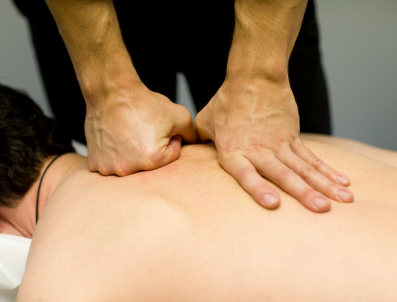Therapeutic Deep Tissue Massage
30-Sep-2013
Deep tissue is a broadly used term for the utilization of deep pressure during massage—usually employing a range of modalities or types of massage (relative to those practiced by the therapist) with the goal of accessing muscle groups beneath the superficial layers. This process lengthens and stretches soft tissue fibers, relieves fatigue from overuse or injury, disperses adhesions (the binding of fascia with collagen, also known as ‘knots’), increases joint flexibility and provides the client with a more thorough sense of relief. While the goal of deeper work is not relaxation per se, as one might imagine with Swedish or lighter touch modalities, the end results can be profoundly calming.
Muscle Adhesions
When muscles are strained by overexertion or injury, the body reacts by sending collagen to the swollen muscle fibers and/or micro-tears in the tissue. This natural form of bandaging is an attempt to repair the area by adding strength. Think of it as a cast for the muscle. This can be a very good thing in the short term, especially when injuries are involved and the fibers are torn. Overtime however, these interwoven, hardened bands continue to expand, become uncomfortably ‘knotty’ and begin to affect the range of motion and general mobility. Using deep pressure to the affected area along with heat therapies can help dissolve the casting that was once beneficial but is now creating its own set of issues.
Lengthening and Flexibility
Muscles groups in the body are layered, overlapping one another, crossing over joints and attaching to bones in an intricate framework enabling all the wonderful movements of the human body. Muscle enlarges with use, increasing in strength and tone. As the belly of the muscle expands and the tendons that attach themselves to their respective bone become stronger (another collagen structure), range of motion in the joints they serve is decreased. With the expanding center of the muscle, the ends or attachments naturally shorten causing a decrease in flexibility. Deep tissue massage is similar to stretching before exercise, encouraging elasticity along the length of the muscle so that strength and mobility remain in balance. As examples, yoga practitioners can be incredibly flexible, but often lack strength. On the contrary, body builders can be very strong, but their rock hard muscles are often locked into a limited range of movement. Swimmers and dancers require both agility and strength and their bodies develop accordingly.
Detoxification
As with most massage, applying pressure and movement along muscles ‘flushes’ the tissue, removing waste into our bodies’ removal system, primarily through blood and lymphatic circulation. Behind the movement of waste comes fresh nutrients. Working deeply brings this process to more cells below the surface while pushing toxins out to the liver for filtration or the kidneys and sweat glands for elimination. This is why re-hydration after any significant movement, exercise or massage is so important.
Cellular Regeneration
The cells in our bodies are dying and being replaced with new ones constantly. Some tissue does this more rapidly than others. For instance, eye tissue repairs itself quite quickly, while nerve cells can take years to regenerate. Science has shown that movement (both exercise and passive manipulation such as massage) raises the rate with which cells are replaced. This includes displacement of damaged tissue, there by increasing the rate of healing. There are some exceptions such as deep bruises or cancerous cells for which massage is contraindicated.
The Amount of Pressure
No two bodies are exactly alike. The comfort level of the client should dictate the amount of pressure needed in a given area of the body. When pain erupts, the sympathetic nervous system is triggered as a natural form of protection, stress levels increase and the body puts up defenses similar to the primal fright or flight response. This negates one’s intentions of healing. Years of adhesion build-up, lack of exercise, drug use, diet and age are all factors in one’s ability to receive deep work. A deep tissue practitioner, although often intuitive through experience, should ask for feedback from his or her client, look for visual cues in the body and adjust pressure accordingly. Years of neglect will rarely be erased in a few sessions and regularity, as with exercise and diet, are the key to good health maintenance.
Rod Cain, LMT owns and operates Rod Cain Massage Therapy in Burlington, Vermont.